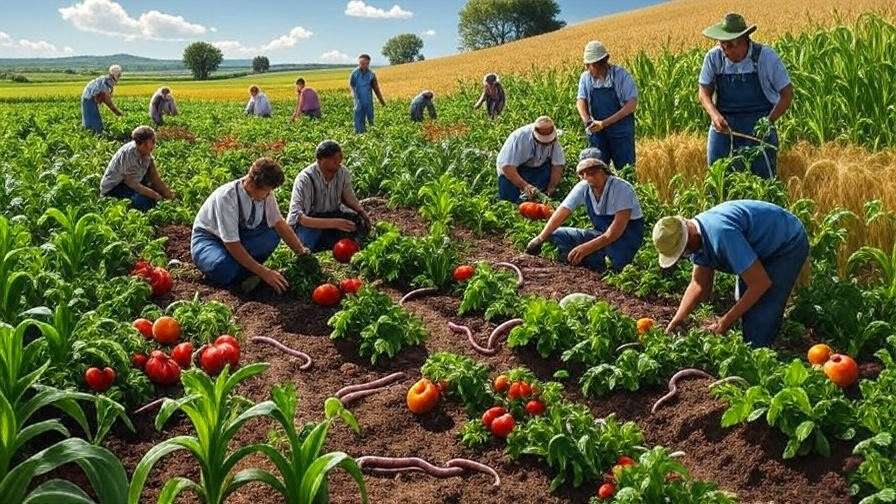Picture a farm where every season brings richer soil, higher yields, and lower costs—all while nurturing the land for future generations. This isn’t a dream; it’s the promise of agroecology commons, a revolutionary approach to farming that’s gaining traction worldwide. Unlike conventional methods that drain the earth and your wallet, agroecology commons blends ecological wisdom, shared resources, and community collaboration to create thriving, sustainable farms. In this article, we’ll explore how this system can transform your farm, boost profitability, and combat environmental challenges. Backed by decades of research, real-world case studies, and insights from leading agroecologists, we’ll guide you through practical steps to adopt agroecology commons and unlock its full potential.
What is Agroecology Commons?
Defining Agroecology Commons
Agroecology commons is a farming framework that integrates ecological principles with collective resource management. It draws on traditional knowledge and modern science to create resilient, sustainable agricultural systems. Unlike conventional farming, which often relies on monocultures and chemical inputs, agroecology commons emphasizes biodiversity, soil health, and community-driven solutions. Think of it as farming with nature, not against it, where shared resources like seeds, water, and knowledge become the backbone of success.
Core Principles of Agroecology Commons
The strength of agroecology commons lies in its guiding principles:
- Biodiversity: Diverse crops and ecosystems enhance resilience and productivity.
- Shared Resources: Farmers collaborate to manage land, water, and seeds, reducing costs and waste.
- Soil Health: Regenerative practices like composting and no-till farming restore fertility.
- Community Engagement: Local networks foster knowledge exchange and collective problem-solving.
These principles aren’t just theoretical—they’re proven to deliver results, as we’ll see in real-world examples.
Why It Matters for Modern Farmers
Today’s farmers face mounting challenges: rising input costs, unpredictable weather, and degraded soils. Agroecology commons offers a solution by reducing reliance on expensive fertilizers and pesticides while building climate-resilient farms. For example, a small-scale farm in Iowa adopted agroecology commons and saw a 20% yield increase within three years, all while cutting input costs by 15%. This approach not only boosts profitability but also ensures long-term sustainability, making it a game-changer for farmers worldwide.
The Challenges of Conventional Farming
Environmental Degradation
Conventional farming often prioritizes short-term gains over long-term health. Practices like monocropping and heavy pesticide use have led to alarming consequences. According to the Food and Agriculture Organization (FAO, 2023), 33% of global soils are degraded, reducing fertility and threatening food security. Erosion, nutrient depletion, and biodiversity loss are eroding the foundation of agriculture, making it harder for farmers to maintain viable operations.
Economic Pressures
The financial toll of conventional farming is steep. Chemical fertilizers, pesticides, and machinery drive up costs, while monoculture crops expose farmers to market volatility. A 2024 study by the International Panel of Experts on Sustainable Food Systems (IPES-Food) found that small-scale farmers spend up to 40% of their income on inputs. For many, this creates a cycle of debt and dependency. Take the case of a corn farmer in Nebraska who faced mounting loans due to reliance on chemical inputs and declining yields.
Social Disconnect
Beyond economics, conventional farming often isolates farmers from their communities. The shift to industrial agriculture has eroded traditional knowledge and weakened rural networks. As urbanization grows, farmers lose access to local support systems, leaving them vulnerable to market and environmental shocks. This disconnect threatens not just livelihoods but the cultural heritage of farming.
How Agroecology Commons Solves These Problems
Restoring Soil Health

Healthy soil is the heart of any farm, and agroecology commons prioritizes regenerative practices to rebuild it. Techniques like cover cropping, crop rotation, composting, and no-till farming improve soil structure, enhance water retention, and boost nutrient cycling. Dr. Rattan Lal, a renowned soil scientist, notes that regenerative practices can increase soil organic carbon by up to 1% annually, significantly enhancing fertility. For farmers, this translates to higher yields and lower input costs over time.
Reducing Costs and Increasing Profitability
Agroecology commons slashes expenses by replacing synthetic inputs with natural alternatives. For instance, integrated pest management uses beneficial insects to control pests, while organic compost replaces chemical fertilizers. A cooperative in India adopted these practices and reduced costs by 30%, allowing farmers to reinvest savings into their operations. Diversified crops also spread market risks, ensuring stable income even in volatile markets.
Building Climate Resilience

Climate change poses a growing threat to agriculture, with droughts, floods, and heatwaves becoming more frequent. Agroecology commons counters these challenges through climate-smart practices like drought-resistant crops and rainwater harvesting. IPES-Food (2024) reports that agroecological farms are 25% more resilient to climate shocks than conventional ones. For example, a farmer in Senegal used agroforestry to maintain yields during a drought, protecting both crops and income.
Fostering Community Collaboration

At its core, agroecology commons is about people. By forming cooperatives or joining networks, farmers share seeds, equipment, and expertise, reducing costs and building resilience. In Brazil, a community-driven agroecology project revived degraded land by pooling resources and knowledge, increasing local food security. These networks not only solve practical problems but also strengthen social bonds, creating a sense of shared purpose.
Step-by-Step Guide to Implementing Agroecology Commons
Step 1: Assess Your Farm’s Needs
Start by evaluating your farm’s current state. Test soil health, assess water availability, and review existing practices. Local agricultural extension services or affordable soil testing kits (like those from LaMotte) can provide valuable data. Involve neighbors or local farmers to gain a broader perspective—this collaborative approach is key to agroecology commons.
Step 2: Build Biodiversity

Diversity is the cornerstone of agroecological success. Introduce complementary crops, such as intercropping maize with legumes to fix nitrogen in the soil. Start small with 2-3 crops to minimize risk while learning. For example, a farmer in Mexico paired tomatoes with marigolds to deter pests naturally, boosting yields by 10%. Companion planting charts, available online, can guide your choices.
Step 3: Adopt Regenerative Practices
Incorporate techniques like mulching, agroforestry, and integrated pest management. Composting is a great starting point: collect organic waste (e.g., crop residues, kitchen scraps) and create a compost pile to enrich soil. A 2023 study in Agroecology and Sustainable Food Systems found that agroforestry increased yields by 15% in tropical climates. For beginners, focus on one practice, like mulching, and scale up over time.
Step 4: Engage Your Community

Join or form a local agroecology network to share resources and knowledge. Seed banks, for instance, allow farmers to access diverse, locally adapted seeds at low cost. In Kenya, a community seed-sharing program preserved heirloom varieties and improved crop resilience. Host workshops or field days to build trust and exchange ideas—collaboration is the heart of agroecology commons.
Step 5: Monitor and Adapt

Track progress using farm management apps like FarmLogs or simple spreadsheets. Monitor soil health, yields, and costs over time to measure impact. Be patient: while some benefits (like improved soil structure) appear within a year, significant yield increases may take 2-3 seasons. Adjust practices based on data and community feedback to optimize results.
Real-World Success Stories
Case Study 1: A Small-Scale Farm in the Midwest
In Iowa, a 50-acre farm transitioned from corn monoculture to agroecology commons in 2020. By implementing crop rotation, cover cropping, and a community seed bank, the farmer increased yields by 15% and cut input costs by 40%. The farm now serves as a model for local growers, hosting workshops to share agroecological techniques.
Case Study 2: A Cooperative in Sub-Saharan Africa
In Ethiopia, a cooperative of 200 farmers adopted agroecology commons to combat drought. Using agroforestry and shared irrigation systems, they doubled production and improved food security for their community. The cooperative’s success attracted government support, providing grants to expand their efforts.
Lessons Learned
Transitioning to agroecology commons isn’t without challenges. Initial costs (e.g., soil testing, new seeds) and a learning curve can deter farmers. However, gradual adoption, community support, and grants (like those from the USDA’s Sustainable Agriculture program) can ease the process. Start small, seek local expertise, and stay committed to long-term gains.
Tools and Resources for Agroecology Commons
Practical Tools
Implementing agroecology commons doesn’t require expensive equipment—many tools are affordable and accessible. Soil testing kits, like those from LaMotte or MySoil, provide critical data on pH, nutrients, and organic matter, costing as little as $20. For crop planning, open-source apps like FarmLogs or AgriApp help track planting schedules and yields. Composting systems can be built with basic materials like wooden pallets or barrels, making them feasible for any farm size. These tools empower farmers to make data-driven decisions and optimize agroecological practices.
Educational Resources
Knowledge is key to a successful transition. Books like Agroecology: The Ecology of Sustainable Food Systems by Stephen Gliessman offer a deep dive into the science and practice of agroecology. The Food and Agriculture Organization (FAO) provides free online courses on agroecology, covering topics from soil management to biodiversity. Global networks like La Via Campesina connect farmers with peer-to-peer learning opportunities, sharing practical insights from diverse regions. Local universities or extension services often host workshops, providing hands-on training tailored to your area’s climate and soil.
Funding and Support
Transitioning to agroecology commons can involve upfront costs, but funding is available. In the U.S., the USDA’s Sustainable Agriculture Research and Education (SARE) program offers grants for regenerative farming projects, with awards up to $15,000 for small farms. In Europe, the Common Agricultural Policy (CAP) supports eco-friendly practices through subsidies. Nonprofits like the Rodale Institute and regional cooperatives often provide technical assistance and low-cost resources. Research local NGOs or government programs to find tailored support—many prioritize agroecology as part of climate resilience initiatives.
FAQs About Agroecology Commons
What is the difference between agroecology commons and organic farming?
Organic farming avoids synthetic chemicals but often operates within conventional frameworks like monoculture. Agroecology commons goes further, integrating ecological balance, biodiversity, and community collaboration. While organic certification focuses on inputs, agroecology commons emphasizes holistic systems that restore ecosystems and empower farmers.
Can small farms adopt agroecology commons?
Absolutely. Agroecology commons is scalable, making it ideal for small farms. Start with low-cost practices like composting or intercropping, and leverage community networks to share resources. Small farms often benefit most, as they can adapt quickly and build local resilience.
How long does it take to see results?
Soil health improvements, like increased organic matter, can appear within 1-2 years. Significant yield increases and cost savings typically take 2-3 seasons, depending on your starting point and practices. Consistent monitoring and adaptation accelerate results.
Are there risks to transitioning?
Initial costs (e.g., soil tests, new seeds) and a learning curve are common challenges. However, starting small, seeking grants, and collaborating with local farmers mitigate risks. The long-term benefits—higher yields, lower costs, and climate resilience—far outweigh temporary hurdles.
Conclusion
Agroecology commons offers a transformative path for farmers seeking sustainability, profitability, and resilience. By restoring soil health, reducing costs, building climate-smart systems, and fostering community collaboration, this approach addresses the core challenges of modern agriculture. Real-world success stories, from Iowa to Ethiopia, prove its potential to revolutionize farming. Start small with one practice—composting, crop rotation, or a community seed bank—and connect with local networks to amplify your impact. Agroecology commons isn’t just a farming method; it’s a movement for a sustainable, equitable future. Share your experiences in the comments or join a local agroecology network to take the first step today.










